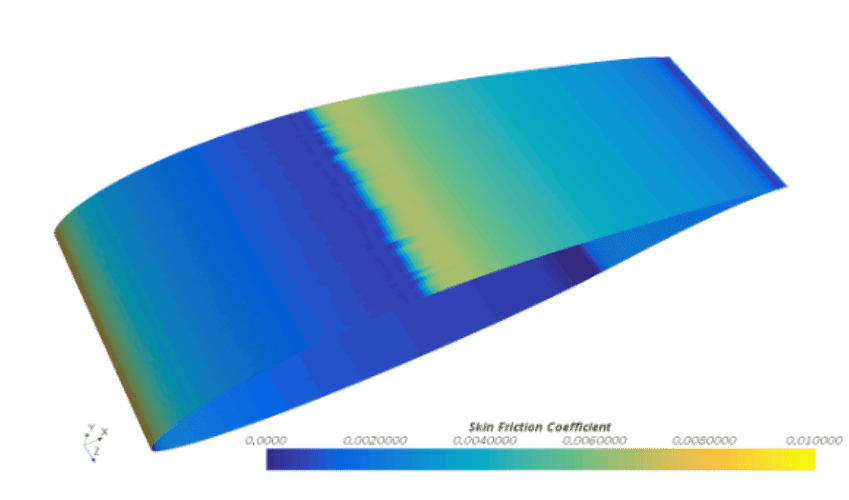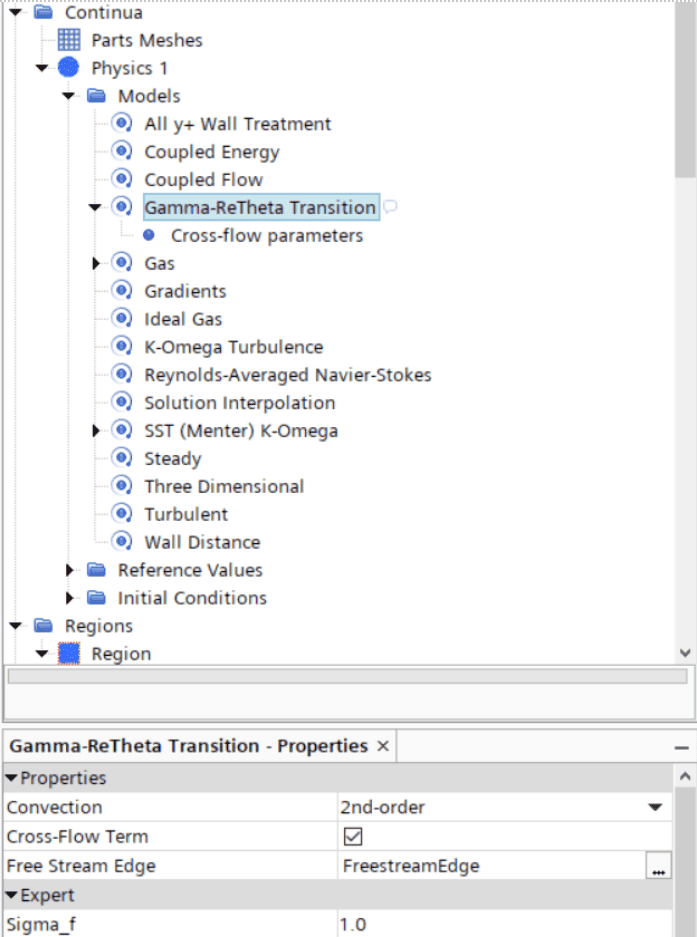In this week’s blog post we are looking into transition modelling. Here we have collected the information that is available on Support Center and in the documentation into one document, together with some tips, which hopefully will help you in your transition flow simulations.
Different types of transition
Transition flow is when the flow goes from laminar to turbulent. There are three types of transition:
- Natural transition – When the flow is gradually transitioning from laminar to turbulent, with small fluctuations introduced in the flow due to that turbulence is induced.
- Bypass transition – When external disturbances cause a sudden transition from laminar to turbulent. Fluctuations (turbulence) in the free stream outside of the boundary layer counts as external in this case.
- Separation induced transition – When you have laminar separation, and the flow reattaches in the turbulent boundary layer, for example when a separation bubble occurs on an airfoil with laminar flow.

Modelling of transition in Simcenter STAR-CCM+
Transition modelling is of importance when the transition is included in the physics you want to simulate. For many applications the transition is not worth modelling since it is not the driving phenomenon in your system. But if you are looking at lift/drag for example, transition effects can affect the flow field to a large extent. It is therefore important to model transition to get the correct results. For example, if you have separation induced transition the separation bubble cannot be captured with turbulence models only, a transition model is therefore needed.
There are three transition models in Simcenter STAR-CCM+:
- Gamma transition – which is a one-equation model, and it is the easiest to use. The model does not need any user input. The model solves for turbulence intermittency (fluctuations) only, so the transport equation for transition momentum thickness Reynolds number is avoided. The transition momentum thickness Reynolds number is instead computed using local variables in the flow field.
- Gamma-ReTheta – is a two-equation model which extends the gamma transition model with a computing of the transition momentum thickness Reynolds number based on user input. The transition momentum thickness Reynolds number is basically the Reynolds number using the boundary layer thickness as characteristic length. The user input will be defined as a field function called Free stream edge field function. The field function should define where the boundary layer is located, with a value of 0 inside the boundary layer and a value of 1 in the free stream (note that you are defining the inside of the boundary layer with the value of zero). Knowing exactly where the boundary layer is located is not easy, so a good guideline is to define the boundary layer using the approximation of twice the turbulent boundary layer thickness from flat plate theory, “WallDistance > 2*delta99 ? 1:0″, where “delta99 = 0.37*L/(ReL^(1/5))”, as described in this Support Center article.
- Turbulence suppression – this model needs input for where the transition occurs. This makes the model mostly useful for comparing results with experiments. The model is called a zero-equation model since it is not actually modelling the transition.
As result from a transition simulation, you will obtain something like the picture below. Here you can see that you have higher skin friction where you have transition happening on the airfoil. The skin friction is definied like τ_wall divided by 0.5 times ρ times U_∞, which has the physical meaning wall friction divided by dynamic pressure (half of the density times the free stream velocity).

Tips for the transition model set up in Simcenter STAR-CCM+
Since transition modelling is dealing with quite sensitive physics there are several things to consider when setting up the simulation.
- Mesh – Transition modelling is sensitive to mesh resolution, and especially if you run with the Gamma-ReTheta model. The general guideline is to have a y+ value below 1 for the entire surface, using Volupe’s y+ calculator, can make sure that you fulfill this requirement. Another guideline is to never stretch your prism layers more than 20% (stretch factor 1.2) per layer. In the article, from Support Center, you can read more about the specific requirements for the mesh.
- Turbulent boundary conditions – Since turbulence dissipates in a CFD simulation it can be difficult to make sure you have the correct turbulence intensity in the flow field. Using the guideline described by Philippe R.Spalart et.al, the turbulent kinetic energy (k) should be defined as 1e-4*U*U and the specific dissipation rate (omega) as 5*U*L (where U is the velocity and L is the characteristic length) as boundary/initial conditions in your simulation, to obtain a good approximation of the turbulence [1].
- Cross-flow terms – For the Gamma-ReTheta model you can enable cross-flow terms for taking instabilities in the flow into account. As R.B Langtry et.al describes in their report, added source terms in the transport for transition momentum thickness Reynolds number can make the prediction of transition more accurate [2]. The option to include cross-flow terms is available for the Gamma transition model as well, but here the cross-terms are implemented as modifications of the transition trigger function which activates the production term for turbulence intermittency. In the picture below you see how to enable the cross-flow terms in Simcenter STAR-CCM+. If you want more information about cross-flow terms you can read the Support Center article.

For more information about transition modelling we at Volupe recommend you to look at the Siemens TV broadcast on this topic before running your simulations.
With that said, we hope that this information was helpful for your simulations including transition from laminar to turbulent flow. I you have any questions, feel free to contact us at support@volupe.com.
References
[1] Effective Inflow Conditions for Turbulence Models in Aerodynamic Calculations, Philippe R. Spalart and Christopher L. Rumsey, October 2007.
[2] Extending the Gamma-ReTheta local correlation based transition model for crossflow effects, Langtry, R. B., Sengupta K., Yeh, D. T., and Dorgan, A. J., AIAA Fluid Dynamics Conference 2015, USA.
Author
Christoffer Johansson, M.Sc.
support@volupe.com
+46764479945
